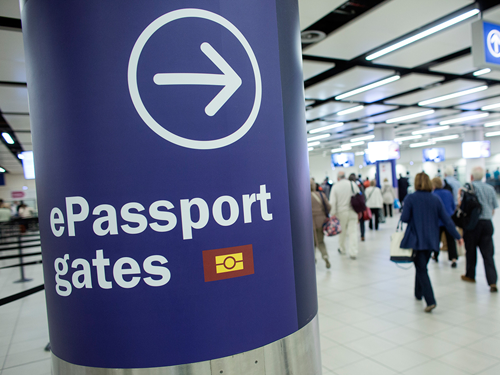Around the world, international Border Control is going digital with electronic passports and self-scan immigration gates. New high-speed chips by Infineon Technologies benefit travelers, airlines and airport operators alike.
According to current ICAO (International Civil Aviation Organization) estimates the number of passengers in civil aviation will more than double in the coming 15 years. An airport such as Frankfurt may then have to handle almost 400.000 passengers on a single peak day which is almost 60% of the city’s total population. Larger planes are one prerequisite to accommodate this development. But on the ground, space available for airport terminals and conventional methods of passport control will have their limits: “As the increasing number of air passengers, longer queues and waiting times will turn passport control into a growing bottleneck, automated border control will become essential for international air travel”, says Dr. Detlef Houdeau from Infineon Technologies, a leading supplier of security chips for electronic IDs and passports.
However, the implementation of eGates is just one side of this solution, secure and high-performance electronic machine-readable travel documents (eMRTDs) for every passenger another. “With eGates, the technical capabilities and advantages of eMRTDs will come into full effect”, says Houdeau. “They enable efficient passenger handling and increase security of border control at the same time,” he adds.
However, the implementation of eGates is just one side of this solution, secure and high-performance electronic machine-readable travel documents (eMRTDs) for every passenger another.
Worldwide, more than 110 states are already issuing electronic travel documents – with the largest annual run rates in the US and in China.
The European Commission launched the smart border package initiative in late 2013, which addresses eGates, Exit-Entry-Schengen (EES) and Registered Traveler Programs (RTP) for 3rd country nationals. And as of 2016, the transition to a population-wide ownership of eMRTDs in Europe will be almost complete. EU citizens will have an electronic passport with their biometric and personal data stored on a computer chip.
“But given the growing number of passengers and more and more data stored on the passport, the next thing we need in order to avoid congestion at border control, is increased data storage capacity and speed performance at the eGate”, says Houdeau.
Infineon provides a security chip for electronic passports and eIDs with increased memory density and an extraordinarily fast data transfer rate. “A passport generally in use today carries personal data and a biometric photo. If your passport contained the new Infineon chip, the data could be transferred to and read by the electronic gate in less than a second,” says Houdeau. However, any additional information such as fingerprints stored on the document consume additional transfer and calculation time at the eGate.
Fast data transfer will become all the more important with regards to future ICAO requirements. The organization is working on standards for electronic passports which in the coming three to five years could store electronic visas, electronic entry and exit stamps or even loyalty points for frequent traveler programs. As such, a frequent traveler’s passport could easily contain up to 150 electronic visas and stamps and would need approximately 8-10 seconds to transfer the data to the electronic gate with conventional chip solutions, whilst only 3 seconds with the new high-speed Infineon chip.
A few seconds less per person might seem negligible at first sight, but if two A380 passenger planes carrying 1100 people arrive at an airport simultaneously and for all of the passengers there would only be three eGates available, the last person in the queue would have to wait for about 60 minutes when using current technologies. If their electronic documents would all be equipped with the new Infineon chip, the time spent at the automatic border control could be reduced by two-thirds which means to a maximum of 20 minutes only.
Faster passenger handling per eGate means higher throughput and requires less eGates. Valuable space which could be dedicated for commercial use thus making airports more attractive for passengers and airlines alike.
“I am convinced that the positive effects of the eGate system combined with our high speed chips will also generate more business for airlines and airport operators”, says Houdeau. One reason is that saved time at border control transfers directly to higher retail revenue per passenger. Other benefits for airlines arise through the integration of loyalty programs, lounge access verification and other marketing tools onto the ePassport.
But the new chip also has a high potential in terms of security. “Advancing machine-to-machine communication and the expansion of a homogenous global security network will help to eliminate human error at border control. Security breaches due to stolen travel documents like aboard the disappeared Malaysia airlines MH370 should then be a thing of the past”, adds Houdeau.
About Author:

Detlef Houdeau is responsible for Business Development for the Government Identification (ID) market segment of the Chip Card & Security division. Houdeau first joined Siemens AG in 1985. He held several positions at corporate research and development at Siemens and later the spun off Infineon Technologies AG. Born in Germany, Houdeau holds a Diploma in Machine Construction, focusing on micro-system technology from the Technical University in Berlin, Germany where he also promoted at in 1994. He has published over 50 papers and filed 40 patents in the smart card application segment with focus on the government ID market.







